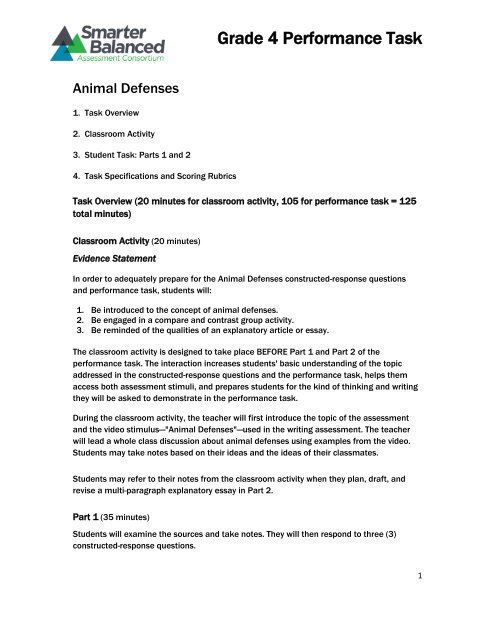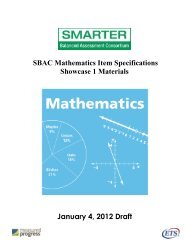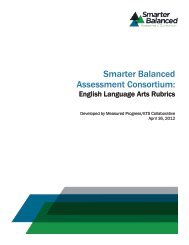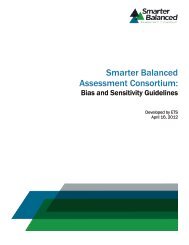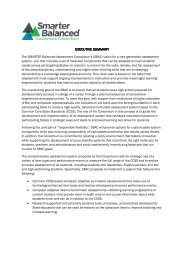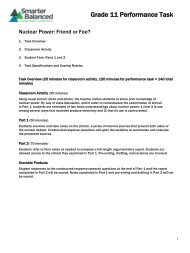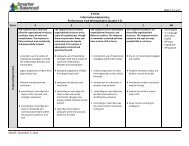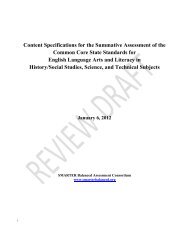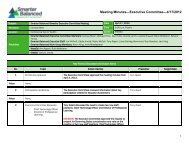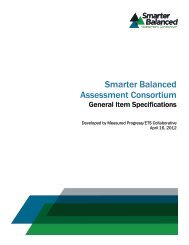Grade 4 Performance Task - Animal Defenses
Grade 4 Performance Task - Animal Defenses
Grade 4 Performance Task - Animal Defenses
Create successful ePaper yourself
Turn your PDF publications into a flip-book with our unique Google optimized e-Paper software.
<strong>Grade</strong> 4 <strong>Performance</strong> <strong>Task</strong><br />
<strong>Animal</strong> <strong>Defenses</strong><br />
1. <strong>Task</strong> Overview<br />
2. Classroom Activity<br />
3. Student <strong>Task</strong>: Parts 1 and 2<br />
4. <strong>Task</strong> Specifications and Scoring Rubrics<br />
<strong>Task</strong> Overview (20 minutes for classroom activity, 105 for performance task = 125<br />
total minutes)<br />
Classroom Activity (20 minutes)<br />
Evidence Statement<br />
In order to adequately prepare for the <strong>Animal</strong> <strong>Defenses</strong> constructed-response questions<br />
and performance task, students will:<br />
1. Be introduced to the concept of animal defenses.<br />
2. Be engaged in a compare and contrast group activity.<br />
3. Be reminded of the qualities of an explanatory article or essay.<br />
The classroom activity is designed to take place BEFORE Part 1 and Part 2 of the<br />
performance task. The interaction increases students' basic understanding of the topic<br />
addressed in the constructed-response questions and the performance task, helps them<br />
access both assessment stimuli, and prepares students for the kind of thinking and writing<br />
they will be asked to demonstrate in the performance task.<br />
During the classroom activity, the teacher will first introduce the topic of the assessment<br />
and the video stimulus—"<strong>Animal</strong> <strong>Defenses</strong>"—used in the writing assessment. The teacher<br />
will lead a whole class discussion about animal defenses using examples from the video.<br />
Students may take notes based on their ideas and the ideas of their classmates.<br />
Students may refer to their notes from the classroom activity when they plan, draft, and<br />
revise a multi-paragraph explanatory essay in Part 2.<br />
Part 1 (35 minutes)<br />
Students will examine the sources and take notes. They will then respond to three (3)<br />
constructed-response questions.<br />
1
<strong>Grade</strong> 4 <strong>Performance</strong> <strong>Task</strong><br />
Part 2 (70 minutes)<br />
Students will have access to the sources they examined in Part 1. They will refer to their<br />
notes and their answers to the constructed-response questions to compose a full-length<br />
explanatory article. Students cannot change their answers to the constructed-response<br />
questions. They will pre-write, draft, and revise an article.<br />
Scorable Products<br />
Students will not generate scorable products during the classroom activity. Student<br />
responses to the constructed-response questions at the end of Part 1 and the article<br />
completed in Part 2 will be scored. Notes completed in Part 1 and pre-writing and drafting<br />
in Part 2 will not be scored.<br />
Teacher Preparation / Resource Requirements<br />
This is a computer-based test that requires an interface for each test-taker. The testing<br />
software will include access to spell check, but not to grammar check. The teacher should<br />
ensure that sufficient blank paper and writing tools are available for student note-taking.<br />
Teacher Directions for the Classroom Activity<br />
Introductory Classroom Activity (20 minutes)<br />
STEP 1: Orientation to the Topic (~4 minutes)<br />
Provide an introduction to the classroom activity by indicating that after this activity,<br />
students will be completing an assessment focused on the topic of animal defenses. Write<br />
the word defense on the board and ask students what it means. (They may be helped by<br />
being reminded of uses of the term like "self-defense.") Be sure that students understand<br />
that a defense is a protection from a threat or harmful condition.<br />
Remind students that humans have to defend themselves too. Ask: "What are some of the<br />
things humans have to defend themselves from? Have you or someone you know ever had<br />
to find protection from a threat of some kind? What are some of the defenses that humans<br />
have created or used for protection?"<br />
STEP 2: Accessing the Stimuli (~13 minutes)<br />
1. Explain: "Now we will look at some animal defenses." Show the video "<strong>Animal</strong> <strong>Defenses</strong>"<br />
(3 minutes 5 seconds).<br />
2. Lead a whole class discussion about the video using the questions below (10 minutes):<br />
2
<strong>Grade</strong> 4 <strong>Performance</strong> <strong>Task</strong><br />
Question 1: In the video "<strong>Animal</strong> <strong>Defenses</strong>," what were the animals defending<br />
themselves against?<br />
Question 2: How do these defenses help the animals protect themselves against<br />
enemies?<br />
STEP 3: Clarify Expectations for the Writing <strong>Task</strong> (~3 minutes)<br />
Explain: "In a few minutes you will read an article and answer some questions about animal<br />
defenses from both the article and the video we just saw. Then you will write an explanatory<br />
essay in response to a particular question."<br />
Explain what students are expected to do in their explanatory essay:<br />
An explanatory essay:<br />
□ Explains information clearly<br />
□ Is well organized and stays on the topic<br />
□ Provides evidence from the sources to support your main idea<br />
□ Uses clear language that suits your purpose<br />
□ Follows rules of writing (spelling, capitalization, punctuation, and grammar)<br />
Answer questions that students might have about the task. Students will keep their notes<br />
from this classroom activity for the "<strong>Animal</strong> <strong>Defenses</strong>" assessment.<br />
Teacher Directions for Parts 1 and 2<br />
Part 1 (35 minutes)<br />
Students should receive the sources, directions, questions, article assignment, and any<br />
other material related to the task. They should receive the constructed-response questions<br />
in Part 1 and the article assignment in Part 2.<br />
1. Initiate the online testing session.<br />
2. Alert the students when there are 15 minutes remaining in Part 1.<br />
3. Alert the students when there are 5 minutes remaining in Part 1.<br />
4. Have students write their names on any notes. Collect all student notes.<br />
5. Close the testing session.<br />
Stretch Break<br />
3
<strong>Grade</strong> 4 <strong>Performance</strong> <strong>Task</strong><br />
Part 2 (70 minutes)<br />
1. Initiate the testing Part 2.<br />
2. Allow students to access the sources, their notes, and their answers to the<br />
constructed-response questions presented in Part 1. They will not be allowed to<br />
change their answers.<br />
3. Once 15 minutes have elapsed, suggest students begin writing the article.<br />
4. Alert the students when 30 minutes remain.<br />
5. Alert students when 15 minutes remain and suggest they begin revising their<br />
articles.<br />
6. Close the testing session.<br />
4
<strong>Grade</strong> 4 <strong>Performance</strong> <strong>Task</strong><br />
Student Directions for Parts 1 and 2<br />
Part 1 (35 minutes)<br />
Your task<br />
You will read an article and watch a video about what animals do to defend themselves<br />
from danger. Then you will answer three questions about what you have learned. In Part 2,<br />
you will write an article that explains how some animals defend themselves.<br />
Steps to follow<br />
In order to plan and write your article, you will do the following:<br />
1. Examine two sources.<br />
2. Make notes about the information from the sources.<br />
3. Answer three questions about the sources.<br />
Directions for beginning<br />
You will now examine two sources. Take notes on both sources. You may use the graphic<br />
organizers to organize your notes if you like. You will want to refer to your notes while<br />
writing your article, but your notes will not be scored. You can re-read the article and watch<br />
the video as often as you like.<br />
5
<strong>Grade</strong> 4 <strong>Performance</strong> <strong>Task</strong><br />
NOTES<br />
SOURCE 1: "<strong>Animal</strong> Roll-Ups" (Ranger Rick article)<br />
<strong>Animal</strong><br />
Type of Defense<br />
NOTE: Your notes will not be scored.<br />
6
<strong>Grade</strong> 4 <strong>Performance</strong> <strong>Task</strong><br />
NOTES<br />
SOURCE 2: "<strong>Animal</strong> <strong>Defenses</strong>" (National Geographic video)<br />
<strong>Animal</strong><br />
Type of Defense<br />
NOTE: Your notes will not be scored.<br />
7
<strong>Grade</strong> 4 <strong>Performance</strong> <strong>Task</strong><br />
Research Questions<br />
After examining the research sources, use the remaining time in Part 1 to answer three<br />
questions about them. Your answers to these questions will be scored. Also, your answers<br />
will help you think about the research sources you have read and viewed, which should help<br />
you write your explanatory article.<br />
You may click on the source buttons to refer back to the sources when you think it would be<br />
helpful. You may also refer to your notes. Answer the questions in the spaces provided<br />
below them.<br />
1. What does the article "<strong>Animal</strong> Roll-Ups" tell you about why some animals curl<br />
up? Use details from the article to support your answer.<br />
2. Think about the armadillo and the hedgehog described in the article "<strong>Animal</strong><br />
Roll-Ups.” In what way are their defenses similar or different? Explain your<br />
answer using details from the article.<br />
3. In the video "<strong>Animal</strong> <strong>Defenses</strong>," the puffer fish and the crab were both<br />
successful in protecting themselves from the same enemy—the sea otter. Do<br />
the puffer fish and the crab have the same type of defense? Explain your answer<br />
and include details from the video in your response.<br />
Part 2 (70 minutes)<br />
You will now have 70 minutes to review your notes and sources, plan, draft, and revise your<br />
article. You may use your notes and refer to the sources. You may also refer to the answers<br />
you wrote to questions in Part 1, but you cannot change those answers. Now read your<br />
assignment and the information about how your article will be scored; then begin your<br />
work.<br />
Your Assignment<br />
Your class is preparing a museum display that will include photos of a variety of animals<br />
and interesting facts about them. You have been asked to write an article for the museum<br />
display explaining about animal defenses.<br />
8
<strong>Grade</strong> 4 <strong>Performance</strong> <strong>Task</strong><br />
In your article<br />
Choose one animal from the article "<strong>Animal</strong> Roll-Ups" and one animal from the video<br />
"<strong>Animal</strong> <strong>Defenses</strong>." In your article, identify your two animals, explain how each animal<br />
protects itself from its enemies, and explain how the two animals’ defenses are similar to<br />
or different from one another. Include details from your sources.<br />
Now begin work on your article. Manage your time carefully so that you can:<br />
<br />
<br />
<br />
plan your article<br />
write your article<br />
revise and edit for a final draft<br />
Word-processing tools and spell check are available to you.<br />
Type your response in the space provided. Write as much as you need to fulfill the<br />
requirements of the task; you are not limited by the size of the response area on the screen.<br />
REMEMBER: A well-written explanatory article:<br />
<br />
<br />
<br />
<br />
<br />
has a clear main idea<br />
is well-organized and stays on the topic<br />
provides evidence from the sources to support your topic<br />
uses clear language that suits your purpose<br />
follows rules of writing (spelling, punctuation, and grammar)<br />
Source Information:<br />
Stimulus #1<br />
Read this article about animals that roll up to defend themselves.<br />
“<strong>Animal</strong> Roll-Ups” by Kathy Kranking, from Ranger Rick Magazine. Copyright © September<br />
2011 by the National Wildlife Federation.<br />
Stimulus #2<br />
Now watch this video about animals and how they defend themselves.<br />
“<strong>Animal</strong> <strong>Defenses</strong>.” Teachers’ Domain. 26 Sept. 2003. Web. 18 Sept. 2012.Sep. 2012.<br />
9
<strong>Grade</strong> 4 <strong>Performance</strong> <strong>Task</strong><br />
<strong>Task</strong> Specifications:<br />
Title: “<strong>Animal</strong> <strong>Defenses</strong>”<br />
<strong>Grade</strong>: 4<br />
Claim(s): 2: Students can produce effective writing for a range of purposes and<br />
audiences.<br />
4: Students can engage in research/inquiry to investigate topics and to<br />
analyze, integrate, and present information.<br />
Primary Target(s): These claims and targets will be measured by scorable evidence collected.<br />
Claim 2 4: COMPOSE FULL TEXTS: Write full informational/explanatory<br />
texts on a topic, attending to purpose and audience: organize ideas by<br />
stating a focus, include structures and appropriate transitional strategies<br />
for coherence, include supporting evidence (from sources when<br />
appropriate to prompt) and elaboration, and develop an appropriate<br />
conclusion.<br />
8: LANGUAGE AND VOCABULARY USE: Strategically use language and<br />
vocabulary (including academic and domain-specific vocabulary)<br />
appropriate to the purpose and audience when revising or composing<br />
texts.<br />
9: EDIT/CLARIFY: Apply or edit grade-appropriate grammar usage and<br />
mechanics to clarify a message and edit narrative, informational, and<br />
opinion texts. Claim 4 2: INTERPRET AND INTEGRATE INFORMATION:<br />
Locate information to support central ideas and subtopics; select and<br />
integrate information from data or print and non-print text sources. 3:<br />
ANALYZE INFORMATION/SOURCES: Distinguish relevant-irrelevant<br />
information (e.g., fact/opinion).<br />
CCSS/Standard(s): W-8, W-9<br />
DOK: 4<br />
Difficulty: Medium<br />
Score Points: Up to 10<br />
<strong>Task</strong> Source: SBAC / CTB / Revisions by Stanford Center for Assessment, Learning, &<br />
Equity (SCALE)<br />
Item Type: <strong>Performance</strong> <strong>Task</strong>s<br />
Target-specific<br />
attributes (e.g.,<br />
accessibility issues):<br />
Students with visual impairments may need alternative formats to access<br />
written texts, graphic stimuli, and video or audiovisual material.<br />
Students with physical or other impairments may need to be provided with<br />
appropriate alternative means to entering lengthy text using a keyboard.<br />
<strong>Grade</strong> level of stimuli: 3/4<br />
Stimuli: <strong>Animal</strong> Roll-Ups: Informational article<br />
This article talks about animals that roll up to protect themselves from<br />
predators.<br />
<strong>Animal</strong> <strong>Defenses</strong>: Educational video<br />
This National Geographic video talks about animals and their different<br />
10
<strong>Grade</strong> 4 <strong>Performance</strong> <strong>Task</strong><br />
How this task<br />
contributes to sufficient<br />
evidence for the claims:<br />
defenses.<br />
In order to complete the performance task, students 1. Analyze and select<br />
information from multiple sources 2. Answer various questions about<br />
research and the evidence the authors present as support 3. Write an<br />
explanatory article, attending to purpose and audience 4. Organize ideas<br />
by stating and maintaining a focus 5. Develop a topic, including citing<br />
supportive evidence, details, and elaboration consistent with the sources,<br />
purpose, and audience 6. Effectively organize ideas, appropriate<br />
transitions, and include a conclusion for coherence 7. Adhere to<br />
conventions and rules of grammar, usage, and mechanics 8. Control<br />
language for purpose and audience<br />
11
<strong>Grade</strong> 4 <strong>Performance</strong> <strong>Task</strong><br />
Scoring information for questions:<br />
1. Claim 4, Target 3<br />
2-point Research (<strong>Grade</strong>s 4–5)<br />
Evaluate Information/Sources Rubric (Claim 4, Target 3)<br />
The response gives sufficient evidence of the ability to distinguish relevant<br />
from irrelevant information such as fact from opinion.<br />
2<br />
The response includes detailed information from the text about how some<br />
animals roll up to defend themselves rather than for other purposes (such as<br />
keeping warm). The response is supported with relevant details from the text.<br />
The response gives limited evidence of the ability to distinguish relevant from<br />
irrelevant information such as fact from opinion.<br />
1<br />
The response includes limited information from the text about how some<br />
animals roll up to defend themselves rather than for other purposes (such as<br />
keeping warm). The response is supported with limited relevant details from<br />
the text.<br />
A response gets no credit if it provides no evidence of the ability to distinguish<br />
relevant from irrelevant information such as fact from opinion.<br />
0<br />
The response does not include an explanation of how some animals roll up to<br />
defend themselves rather than for other purposes (such as keeping warm) or<br />
confuses the reasons why animals roll up. The response does not include<br />
relevant details and may be vague, incorrect, or completely absent.<br />
12
<strong>Grade</strong> 4 <strong>Performance</strong> <strong>Task</strong><br />
Sample 2-Point Response:<br />
The information in the article tells about many animals that roll up in different ways. Many<br />
animals roll up to protect themselves from danger. For example, the armadillo rolls up into<br />
a ball by pulling its ears and legs into the ball and has armor covering it. Some animals, like<br />
the red fox, curl up to keep warm. The stone centipede rolls up into a ball to protect her<br />
eggs.<br />
Scoring note: The response could also mention the pill bug, hedgehog, or wheel spider.<br />
Sample 1-Point Response:<br />
The article “<strong>Animal</strong> Roll-Ups” did a good job of explaining how animals roll up. It also<br />
explains why they roll up. The pill bug rolls up like an armadillo.<br />
Sample 0-Point Response:<br />
I liked reading about animals that roll up.<br />
13
<strong>Grade</strong> 4 <strong>Performance</strong> <strong>Task</strong><br />
2. Claim 4, Target 2<br />
2-point Research (<strong>Grade</strong>s 3–5)<br />
Interpret & Integrate Information Rubric (Claim 4, Target 2)<br />
The response gives sufficient evidence of the ability to locate, select, interpret,<br />
and integrate information within and among sources of information.<br />
2<br />
The response is a thorough explanation of how the defenses of the armadillo<br />
and the hedgehog are similar or different. The response is supported with<br />
relevant details from the text.<br />
The response gives limited evidence of the ability to locate, select, interpret,<br />
and integrate information within and among sources of information.<br />
1<br />
The response is a limited explanation of how the defenses of the armadillo and<br />
the hedgehog are similar or different. The response is supported with limited<br />
details from the text.<br />
0<br />
A response gets no credit if it provides no evidence of the ability to locate,<br />
select, interpret, and integrate information within and among sources of<br />
information.<br />
The response does not relate to the similarities or differences of the defenses<br />
of the armadillo and the hedgehog. The response does not include relevant<br />
details and may be vague, incorrect, or completely absent.<br />
14
<strong>Grade</strong> 4 <strong>Performance</strong> <strong>Task</strong><br />
Sample 2-Point Response:<br />
Armadillos and hedgehogs defend themselves in similar ways because they both try to fool<br />
their enemies and protect their bodies. Armadillos curl up into a ball and pull their head and<br />
tail inside their armor. Hedgehogs also curl up into a ball and hide their soft parts under<br />
their sharp spines. These defenses help the animals protect themselves.<br />
Sample 1-Point Response:<br />
Armadillos and hedgehogs curl up into balls to defend themselves.<br />
Sample 0-Point Response:<br />
I enjoyed reading the article.<br />
3. Claim 4, Target 2<br />
2-point Research (<strong>Grade</strong>s 3–5)<br />
Interpret & Integrate Information Rubric (Claim 4, Target 2)<br />
The response gives sufficient evidence of the ability to locate, select, interpret,<br />
and integrate information within and among sources of information.<br />
2<br />
The response is a thorough explanation of whether or not the puffer fish and the<br />
crab have the same type of defense. The response is supported with relevant<br />
details from the video.<br />
The response gives limited evidence of the ability to locate, select, interpret,<br />
and integrate information within and among sources of information.<br />
1<br />
The response is a limited explanation of whether or not the puffer fish and the<br />
crab have the same type of defense. The response is supported with limited<br />
relevant details from the video.<br />
15
<strong>Grade</strong> 4 <strong>Performance</strong> <strong>Task</strong><br />
0<br />
A response gets no credit if it provides no evidence of the ability to locate,<br />
select, interpret, and integrate information within and among sources of<br />
information.<br />
The response does not include an explanation of whether or not the puffer fish<br />
and the crab have the same type of defense. The response does not include<br />
relevant details and may be vague, incorrect, or completely absent.<br />
Sample 2-Point Response:<br />
The puffer fish and the crab have very different types of defenses. The puffer fish puffs up to<br />
make itself so large that an enemy can’t bite it. It also makes itself hard to bite with<br />
thousands of prickles on it. The crab has sharp claws that it snaps at the otter in the video,<br />
and this keeps the otter away from it. They have very different responses, but they are both<br />
successful at defending themselves.<br />
Sample 1-Point Response:<br />
The puffer fish puffs up to make itself so large that the otter can’t bite it. The crab in the<br />
video uses its claws to snap at the otter. In these ways they are different.<br />
Sample 0-Point Response:<br />
Otters like to try to eat puffer fish and crabs.<br />
16
Statement of Purpose/Focus and Organization<br />
<strong>Grade</strong> 4 <strong>Performance</strong> <strong>Task</strong><br />
Rubric and scoring information for full-write:<br />
4-Point<br />
Informative-Explanatory<br />
<strong>Performance</strong> <strong>Task</strong> Writing Rubric (<strong>Grade</strong>s 3–5)<br />
Score 4 3 2 1 NS<br />
The response is fully<br />
sustained and<br />
consistently and<br />
purposefully focused:<br />
controlling idea or<br />
main idea of a topic<br />
is clearly stated,<br />
focused, and strongly<br />
maintained<br />
controlling idea or<br />
main idea of a topic<br />
is introduced and<br />
communicated<br />
clearly within the<br />
purpose, audience,<br />
and task<br />
The response has a clear<br />
and effective<br />
organizational structure<br />
creating a sense of unity<br />
and completeness:<br />
consistent use of a<br />
variety of transitional<br />
strategies to clarify<br />
the relationships<br />
between and among<br />
ideas<br />
logical progression of<br />
ideas from beginning<br />
to end<br />
effective introduction<br />
and conclusion for<br />
audience and<br />
purpose<br />
The response is<br />
adequately sustained<br />
and generally focused:<br />
controlling idea or<br />
main idea of a topic<br />
is clear and mostly<br />
maintained, though<br />
some loosely<br />
related material<br />
<br />
may be present<br />
some context for<br />
the controlling idea<br />
or main idea of the<br />
topic is adequate<br />
within the purpose,<br />
audience, and task<br />
The response has an<br />
evident organizational<br />
structure and a sense of<br />
completeness, though<br />
there may be minor<br />
flaws and some ideas<br />
may be loosely<br />
connected:<br />
adequate use of<br />
transitional<br />
strategies with<br />
some variety to<br />
clarify the<br />
relationships<br />
between and among<br />
ideas<br />
adequate<br />
progression of ideas<br />
from beginning to<br />
end<br />
adequate<br />
introduction and<br />
conclusion<br />
The response is<br />
somewhat<br />
sustained and may<br />
have a minor drift in<br />
focus:<br />
may be clearly<br />
focused on the<br />
controlling or<br />
main idea, but<br />
is insufficiently<br />
<br />
sustained, or<br />
controlling idea<br />
or main idea<br />
may be unclear<br />
and/or<br />
somewhat<br />
unfocused<br />
The response has an<br />
inconsistent<br />
organizational<br />
structure, and flaws<br />
are evident:<br />
inconsistent use<br />
of transitional<br />
strategies<br />
and/or little<br />
<br />
<br />
variety<br />
uneven<br />
progression of<br />
ideas from<br />
beginning to<br />
end<br />
conclusion and<br />
introduction, if<br />
present, are<br />
weak<br />
The response may<br />
be related to the<br />
topic but may<br />
provide little or no<br />
focus:<br />
may be very<br />
brief<br />
may have a<br />
major drift<br />
focus may be<br />
confusing or<br />
ambiguous<br />
The response has<br />
little or no<br />
discernible<br />
organizational<br />
structure:<br />
few or no<br />
transitional<br />
strategies are<br />
evident<br />
frequent<br />
extraneous<br />
ideas may<br />
intrude<br />
Insufficient,<br />
illegible, in a<br />
language<br />
other than<br />
English,<br />
incoherent,<br />
off-topic, or<br />
off-purpose<br />
writing<br />
17
Evidence/Elaboration<br />
<strong>Grade</strong> 4 <strong>Performance</strong> <strong>Task</strong><br />
4-Point<br />
Informative-Explanatory<br />
<strong>Performance</strong> <strong>Task</strong> Writing Rubric (<strong>Grade</strong>s 3–5)<br />
Score 4 3 2 1 NS<br />
The response provides<br />
thorough and convincing<br />
support/evidence for the<br />
controlling idea or main<br />
idea that includes the<br />
effective use of sources,<br />
facts, and details:<br />
use of evidence from<br />
sources is integrated,<br />
comprehensive, and<br />
relevant<br />
effective use of a<br />
variety of elaborative<br />
techniques<br />
The response clearly and<br />
effectively expresses<br />
ideas, using precise<br />
language:<br />
use of academic and<br />
domain-specific<br />
vocabulary is clearly<br />
appropriate for the<br />
audience and<br />
purpose<br />
The response provides<br />
adequate<br />
support/evidence for the<br />
controlling idea or main<br />
idea that includes the<br />
use of sources, facts,<br />
and details:<br />
some evidence from<br />
sources is included,<br />
though citations<br />
may be general or<br />
<br />
imprecise<br />
adequate use of<br />
some elaborative<br />
techniques<br />
The response<br />
adequately expresses<br />
ideas, employing a mix<br />
of precise with more<br />
general language:<br />
use of domainspecific<br />
vocabulary<br />
is generally<br />
appropriate for the<br />
audience and<br />
purpose<br />
The response<br />
provides uneven,<br />
cursory<br />
support/evidence<br />
for the controlling<br />
idea or main idea<br />
that includes partial<br />
or uneven use of<br />
sources, facts, and<br />
details:<br />
evidence from<br />
sources is<br />
weakly<br />
integrated, and<br />
citations, if<br />
present, are<br />
uneven<br />
weak or uneven<br />
use of<br />
elaborative<br />
techniques<br />
The response<br />
expresses ideas<br />
unevenly, using<br />
simplistic language:<br />
use of domainspecific<br />
vocabulary that<br />
may at times be<br />
inappropriate<br />
for the audience<br />
and purpose<br />
The response<br />
provides minimal<br />
support/evidence<br />
for the controlling<br />
idea or main idea<br />
that includes little<br />
or no use of<br />
sources, facts, and<br />
details:<br />
use of<br />
evidence from<br />
the source<br />
material is<br />
minimal,<br />
absent,<br />
incorrect, or<br />
irrelevant<br />
The response’s<br />
expression of ideas<br />
is vague, lacks<br />
clarity, or is<br />
confusing:<br />
uses limited<br />
language or<br />
domainspecific<br />
vocabulary<br />
may have little<br />
sense of<br />
audience and<br />
purpose<br />
Insufficient,<br />
illegible, in a<br />
language<br />
other than<br />
English,<br />
incoherent,<br />
off-topic, or<br />
off-purpose<br />
writing<br />
18
Conventions<br />
<strong>Grade</strong> 4 <strong>Performance</strong> <strong>Task</strong><br />
2-Point<br />
Informative-Explanatory<br />
<strong>Performance</strong> <strong>Task</strong> Writing Rubric (<strong>Grade</strong>s 3–5)<br />
Score 2 1 NS<br />
The response demonstrates an<br />
adequate command of conventions:<br />
errors in usage and sentence<br />
formation may be present, but no<br />
systematic pattern of errors is<br />
displayed and meaning is not<br />
obscured<br />
adequate use of punctuation,<br />
capitalization, and spelling<br />
The response demonstrates a<br />
partial command of conventions:<br />
errors in usage may obscure<br />
meaning<br />
inconsistent use of punctuation,<br />
capitalization, and spelling<br />
Insufficient, illegible, in a<br />
language other than English,<br />
incoherent, off-topic, or offpurpose<br />
writing<br />
19


